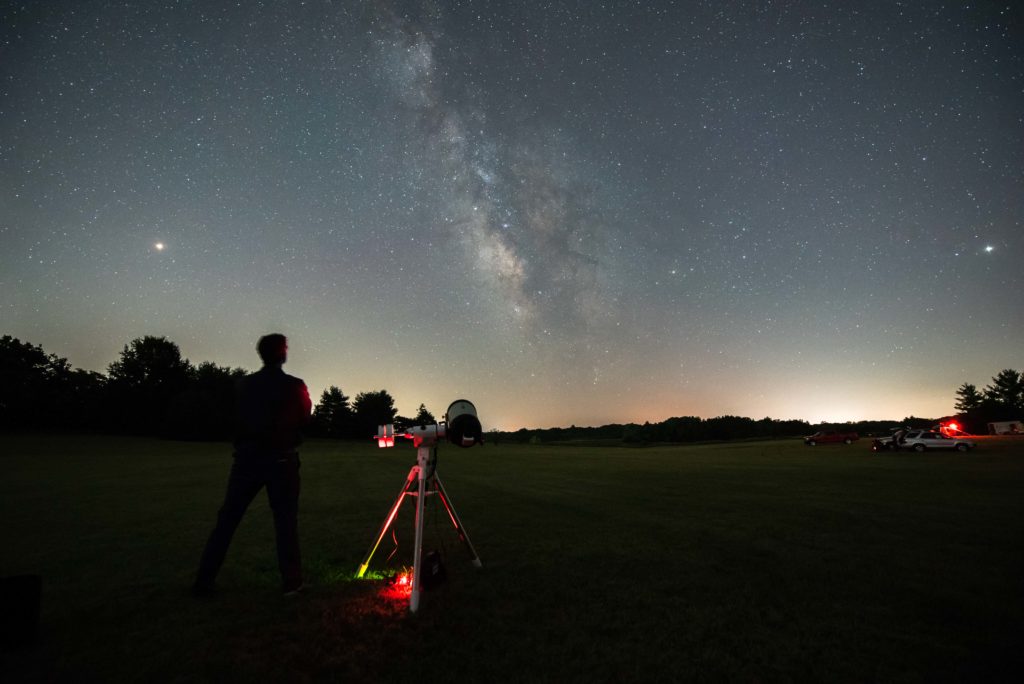
2 July 2019. New Moon, 19:16 UT.
2 July 2019. The Sun is totally eclipsed by the Moon for observers in a narrow band across the southern Pacific Ocean, Chile, and Argentina. The eclipse begins at 1:55 UT and ends at 21:51 UT, with totality peaking at 20:39 UT. The lovely seaside towns of La Serena and Coquimbo, Chile, where many major astronomical observatories have an administrative presence, will enjoy two minutes and thirteen seconds of totality.
3-4 July. The planet Mars lies less than a degree from the waxing crescent Moon in the western sky after sunset low over the western horizon. Mars has faded to near 2nd magnitude and will soon be lost in the Sun’s glare. Closest approach is at about 6:00 UT on July 4, which is the night of July 3 for much of North and South America.
4 July. Earth reaches aphelion, the further point in its orbit around the Sun. Today, the centers of these two celestial bodies are 152,104,285 km apart.
5 July. At dusk in the western sky, look for a newly minted crescent Moon about two finger-widths from the first magnitude star Regulus in the constellation Leo.

8 July. A nearly first-quarter Moon lies just east, about the width of your thumbnail at arm’s length, of the star Porrima in the constellation Virgo. Porrima, or gamma (γ) Virginis, is a splendid if somewhat tight double star that can be resolved at higher magnification in a telescope on a night of good seeing.
9 July. First Quarter Moon, 10:55 UT
9 July. The planet Saturn reaches opposition, rising in the east/southeast just to the left of the Teapot of Sagittarius as the Sun sets in the west. The planet’s brightness peaks at +0.1 this month. The disk of Saturn spans about 18” and the rings are about 42” tip-to-tip. The rings are nicely tilted at about 24 degrees to our point of view making for dramatic viewing. At the beginning of July, the planet reaches its highest point in the sky at about 1:30 a.m. local time. By the end of the month, it culminates about two hours earlier.
12-13 July. Look for the waxing gibbous Moon far south on the ecliptic among the stars of Scorpius and Sagittarius not far from the planets Jupiter and Saturn. Save for the Moon, Jupiter is by far the brightest object in the night sky, shining at magnitude -2.6 and spanning an apparent diameter of 45”. It’s a dazzling sight in a telescope, although northern observers need to wait for moments of steadying seeing since the planet is low in the thick air over the southern horizon. Southern-hemisphere observers will see the planet nearly overhead in much steadier sky.

14 July. The dwarf planet Pluto reaches opposition amid a starry patch of sky in the constellation Sagittarius.
16 July. Full Moon, 21:38 UT
16 July. The planet Saturn is less than a degree north of the full Moon in the constellation Sagittarius.
16-17 July. A partial lunar eclipse is visible over much of the world except for North America. At peak eclipse, about 65% of the Moon will be darkened. The eclipse occurs during the evening of the 16th for observers in Europe and Africa and early on the morning of the 17th in Australia and New Zealand where the eclipse will still be in progress as the Moon sets.

20 July. Look after midnight (or early in the morning after sunrise) for the waning gibbous Moon and contemplate that it was 50 years ago today that humans landed on the our nearest celestial neighbor.
21 July. Mercury reaches inferior conjunction and lies nearly between the Earth and Sun. On its next inferior conjunction, on November 11, the planet will transit the face of the Sun.
25 July. Last Quarter Moon, 01:18 UT
25 July. The planet Uranus is just three finger widths, about 5º, north of the last-quarter Moon. The planet is easily visible in binoculars and resolved into a pale grey-green disk in a small telescope.
28 July. Before sunrise, look to the east-northeast to see the waning crescent Moon near the stars of the small but prominent constellation Taurus.
27-30 July. The Delta Aquarid meteor shower peaks. This annual event favors observers in the southern hemisphere and southerly latitudes in the northern hemisphere, though all observers can see some of these slow-moving meteors. The Delta Aquariids appear to radiate from a point near the star Skat (delta Aquarii) in the constellation Aquarius. The shower peaks around July 27-30, but unlike most meteor showers, the Delta Aquarids lack a sharp maximum so meteors are visible from mid-July through early August. The maximum hourly rate can reach 15-20 meteors in a dark sky.